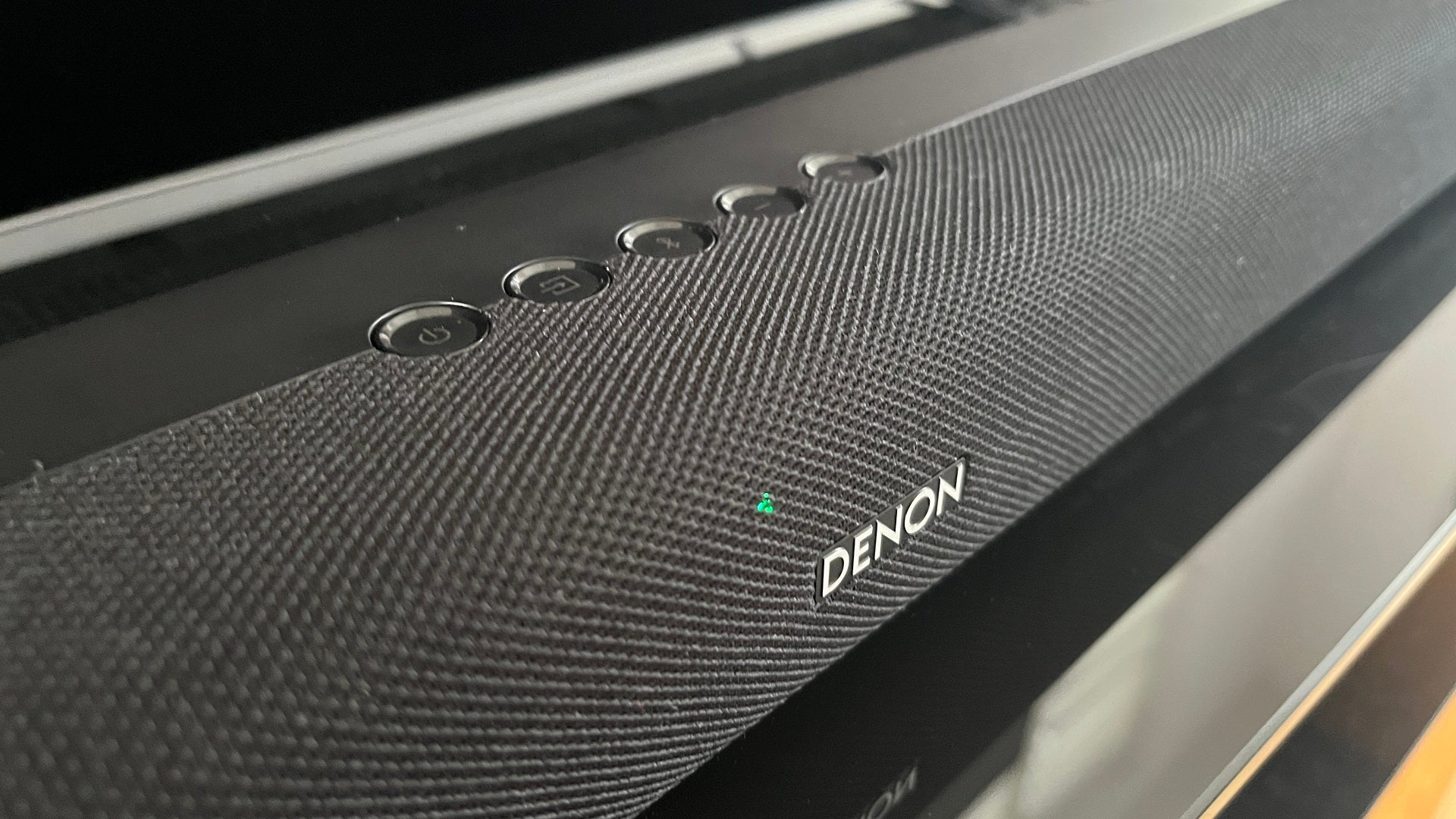Verdict
It’s not without its foibles, but the Denon DHT-S316 is nevertheless a solid and sensible way of getting some worthwhile sound quality out of your TV without spending an arm and a leg.
Pros
- Sounds bigger and better-defined than your average TV
- Very acceptably built and finished
- Decent integration between soundbar and subwoofer
Cons
- Subwoofer can get carried away
- Not short of competition
- Treble sounds lack sparkle
Introduction
Everybody knows that the majority of new TVs sound pretty poor – that’s why we’re always so pleased to find one that sounds OK.
But if you’ve bought an affordable TV that looks good yet sounds woeful (which is almost all of them), what are you to do? Well, buying an affordable soundbar to go with it would be our suggestion.
Something like the Denon DHT-S316, maybe? Let’s find out…
Availability
- UKRRP: £279
- USARRP: $299
- EuropeRRP: €329
- CanadaRRP: CA$499
- AustraliaRRP: AU$495
In the United Kingdom the Denon DHT-S316 sells for no more than £279. American customers will have to part with $299 or thereabouts, while in Australia the going rate is something like AU$495.
By Denon’s standards this is approaching entry-level stuff – but that doesn’t mean it’s without meaningful competition. We’re big fans of Wharfedale’s Vista 200S, for example – and it’s even more affordable than this Denon.
And everyone from JBL and Sonos to Sony and Yamaha are more than happy to part you from similar money in exchange for a similar soundbar, sometimes with a subwoofer thrown in too. In other words, Denon doesn’t exactly have the field clear.
Design
- Soundbar: 55 x 900 x 82mm (HxWxD), 1.8kg
- Subwoofer: 342 x 170 x 318mm (WxWxD), 5.2kg
- Keyhole wall-fixings
Given how affordable it is, it shouldn’t come as any surprise to learn design hasn’t really happened here in any meaningful way. The soundbar itself is made from unremarkable plastic, with its front and front half of its top surface covered in equally unremarkable acoustic cloth. At the rear, there are rudimentary keyhole mounting points in case you want to hang the soundbar on the wall rather than stand it on a shelf.
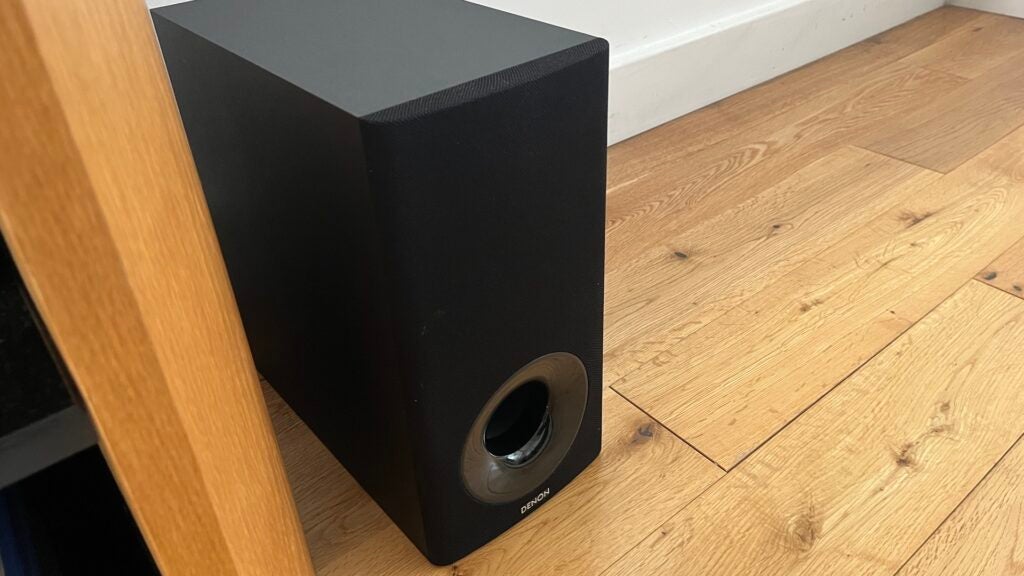
The subwoofer, meanwhile, is built of vinyl-wrapped chipboard. The front is covered with more of that acoustic cloth, and there’s an exposed bass reflex port at the bottom – it’s finished in the same glossy plastic that makes up the end-caps of the soundbar.
Build quality is perfectly adequate, and the way the physical controls on the top of the soundbar bisect the junction between plastic and acoustic cloth is, visually, quite pleasing. But as far as design goes, it’s safe to say that’s your lot.
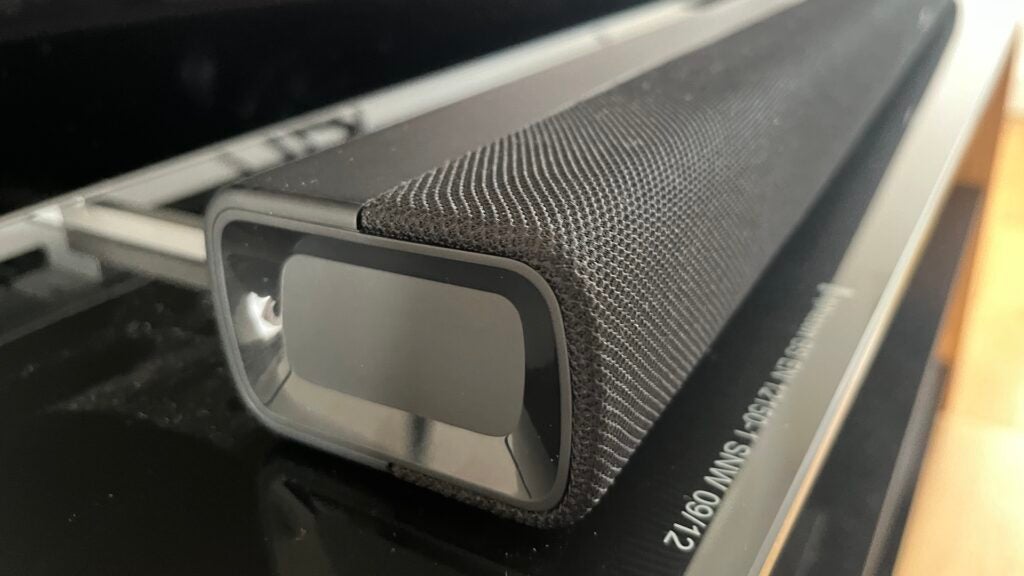
All soundbars are, by definition, designed with function rather than form in mind (unless you’re Bang & Olufsen, of course) – and the DHT-S316 is about as functional as they come. Its dimensions mean it’s happy to accompany TVs as small as 43-inch without looking daft, though, which is handy – and it’s compact enough to sit below all but the lowest-slung screens without getting in the way.
And thanks to its wireless connectivity, the subwoofer can be positioned more-or-less anywhere you fancy – as long as it has access to mains power, obviously.
Features
- 2.1-channel configuration
- HDMI ARC
- Bluetooth 4.2
Not for the first time where products as far down its pecking order as this are concerned, Denon isn’t exactly making with the specification details. So what has Denon said about this bar?
Well, this is a 2.1-channel system. The soundbar features a couple of 25mm tweeters, pushed out towards the ends of the front surface, with a 32 x 112mm racetrack midrange driver on the inside of each one. The ‘.1’ is taken care of by the subwoofer, which features a 140mm bass driver positioned above the forward-facing reflex port. But as to how much power is available to drive this line-up, well, Denon isn’t saying.
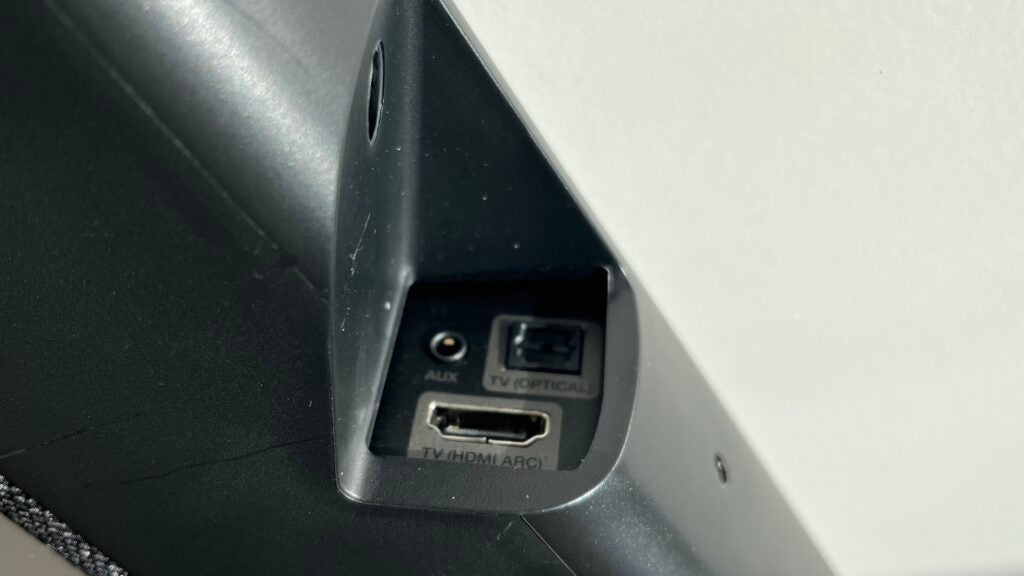
Physical connectivity extends to an HDMI ARC socket, a digital optical input and a 3.5mm analogue input – all three are in a little recess at the rear of the soundbar. They’re grouped tightly together, but are a long way from the figure-of-eight mains connection – so cable-management is a little less straightforward than it might otherwise be.
The subwoofer needs only mains power, and its socket is close to a wireless pairing button that can be pressed in the unlikely event the soundbar and subwoofer don’t automatically introduce themselves.
The soundbar can handle PCM, Dolby Digital 5.1 and DTS 5.1 tracks – although of course these last two are downscaled to suit the Denon’s 2.1 configuration. The soundbar also features Bluetooth 4.2 wireless connectivity, with SBC codec compatibility.
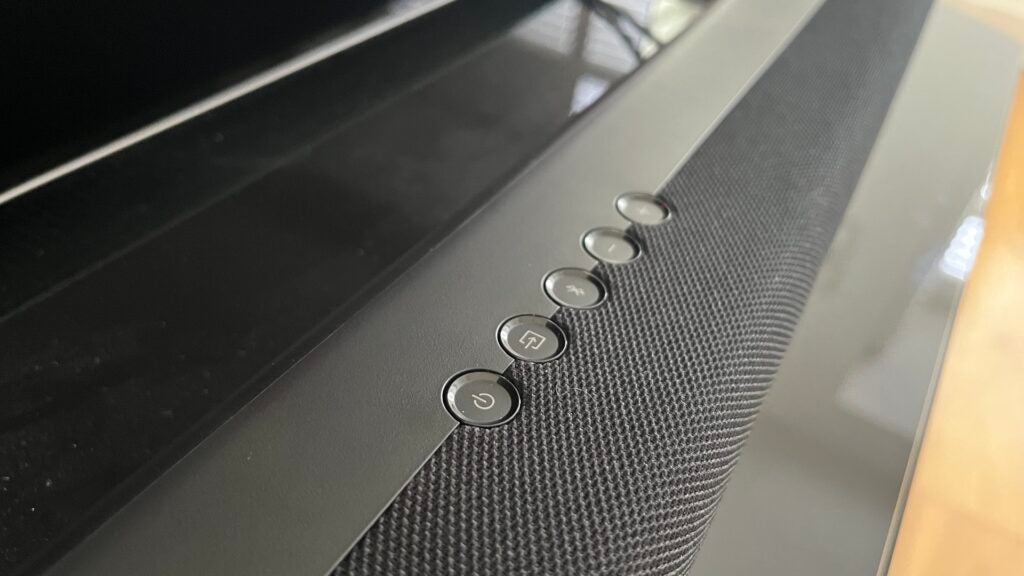
Control is available via the brief selection of physical buttons on the top of the soundbar – here’s where you can handle volume up/down, power on/off, Bluetooth pairing and input selection. The remote control handset duplicates these functions, and adds independent subwoofer volume control, a mute button and three EQs (movie, music and night, the last of which backs off the bass, flattens the dynamic response and shoves the midrange forward a little). There’s also a three-stage dialogue enhancer.
There are four LEDs in the centre of the front of the soundbar, which light up in different colours and/or numbers to indicate what’s what as regards input and volume level. Once you’re mustered the energy to memorise what the combinations mean, it’s a reasonably useful interface.
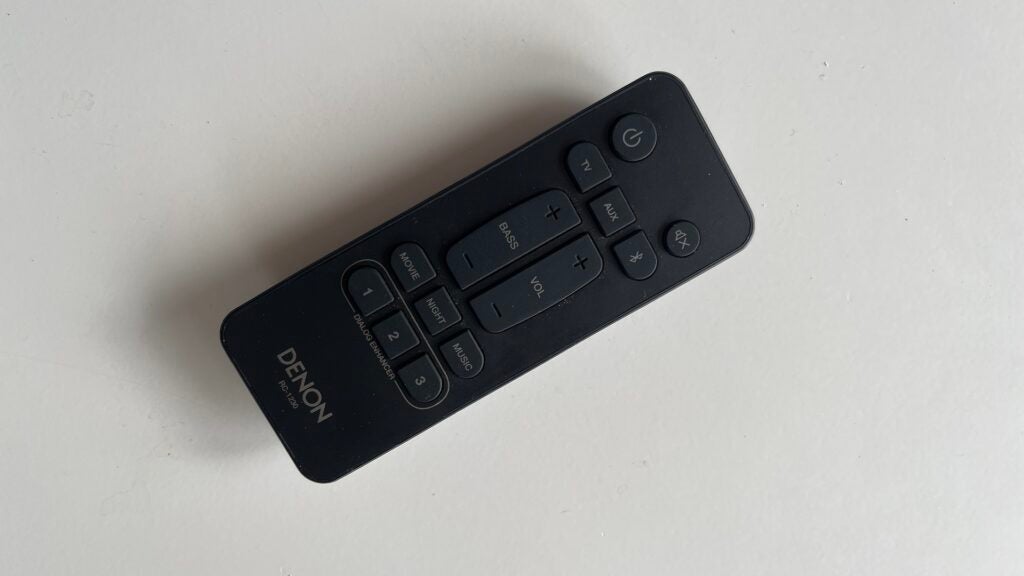
Sound Quality
- Good integration between soundbar and sub
- Scale and dynamism beyond what an ordinary TV is capable of
- Can lose low-end composure at volume
As far as bringing the sound of your television intro closer alignment with its picture quality is concerned, it’s hard to find fault with the Denon DHT-S316. It’s an altogether bigger, more coherent, more dynamic and more assertive listen than the majority of mainstream TVs could ever dream of being.
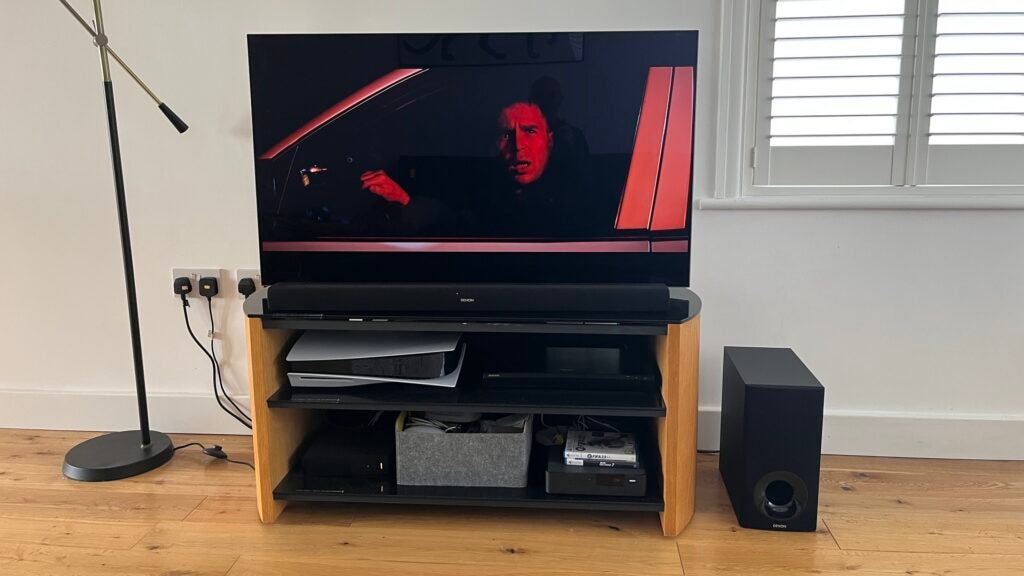
Mind you, finding fault is a big part of why I’m here. So while the DHT-S316 experience is positive in any number of ways, it’s not exactly perfect. So we may as well start with what could quite easily be described as shortcomings.
As far as the soundbar is concerned, the only realistic criticisms concern its treble reproduction. The top end is a little rolled-off and restricted here – so when the going gets toppy, the Denon can’t give full expression to that shattering glass or those bullet-shells tinkling to the floor during any recent action movie you care to mention.
Of course, this is preferable to treble sounds getting edgy or hardening, but there’s always a balance to be struck – the DHT-S316 errs on the side of caution.
The rest of the news regarding the soundbar is pretty good, though. It’s a quite spacious and well-defined listen, able to offer a convincing impression of soundstaging and generating a fair bit of width while it’s at it.
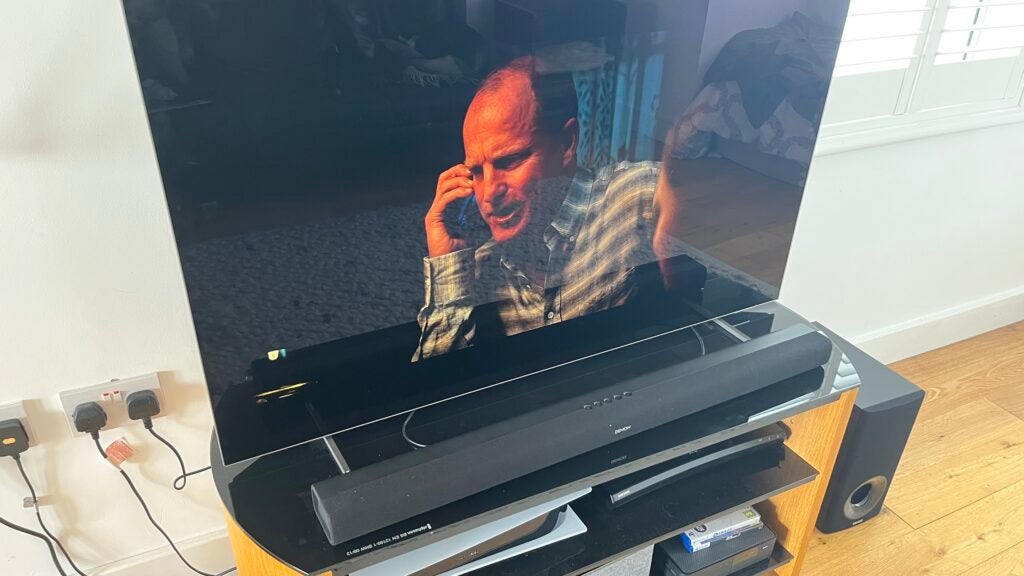
Its midrange reproduction is nicely detailed, projects well and keeps dialogue distinct even if all is mayhem on either side. The dynamic variations it’s asked to deal with during Three Billboards Outside Ebbing, Missouri are handled without alarms, and it retains its composure even when asked to perform at significant volume.
Which, it’s safe to say, is more than can be said for the subwoofer. In its defence, the sub integrates smoothly with the soundbar despite the lack of crossover adjustment, and the low-frequency stuff it generates is quite well shaped, properly controlled and decently straight-edged.
It handles the attack and decay of specific information confidently, and even when the going gets properly bassy it stays in its lane and doesn’t foul the midrange information above it. Or, at least, it does if you’re listening at realistic levels. If you decide to up the volume in the name of movie-night excitement, the subwoofer can quite quickly lose the run of itself – the discipline it exhibits at lower levels goes astray, and consequently so does some of its definition.
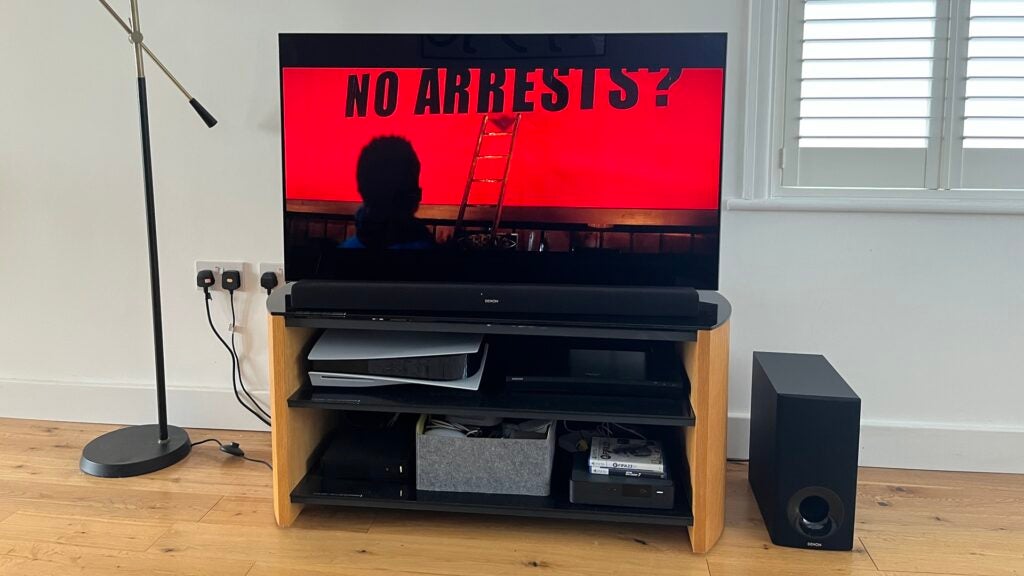
That the DHT-S316 is happier when dealing with the music that’s part of a movie soundtrack than it is handling an SBC Bluetooth wireless stream is undeniable. In the first instance the system is quite poised, reasonably detailed and expresses rhythms pretty well (with the caveats regarding the subwoofer’s relationship with high volumes still strongly applying).
In the second instance, though, rhythms can sound a little lumpy and quite a lot of the soundbar’s definition is erased, too. So it’s best to think of the Denon as an occasional music system, at best.
Latest deals
Should you buy it?
Your TV sounds rotten: For a pretty reasonable outlay, the DHT-S316 will bring greater sonic scale, presence and insight to your viewing pleasure.
You like to listen at big, cinema-style volumes: The Denon’s soundbar is pretty relaxed about that. The Denon’s subwoofer is not.
Final Thoughts
You’re not short of choice where soundbars (or soundbar/subwoofer combos) at this sort of money are concerned – but, let’s face it, seldom did anyone have buyer’s regret after choosing a Denon product.
If you already have a Sonos audio system then the HDMI-less Ray may make more sense, but otherwise the Denon – for all that it’s not exactly perfect – deserves proper consideration.
How we test
We test every soundbar we review thoroughly over an extended period of time. We use industry standard tests to compare features properly. We’ll always tell you what we find. We never, ever, accept money to review a product.
Find out more about how we test in our ethics policy.
FAQs
No, there’s no support for Atmos immersive audio on this bar, it only supports Dolby Digital 5.1, DTS 5.1 and PCM.
Sustainability
Trusted Reviews’ holds the fact that global warming is not a myth as a core value and will continuously endeavour to help protect our planet from harm in its business practices.
As part of this mission, whenever we review a product we send the company a series of questions to help us gauge and make transparent the impact the device has on the environment.
We currently haven’t received answers to the questions on this product, but will update this page the moment we do. You can see a detailed breakdown of the questions we ask and why in our sustainability info page.
Jargon buster
Dolby Atmos
Dolby Atmos is an object-based audio format. It expands on 5.1 and 7.1 soundtracks by adding overhead channels. Sounds are referred to as “audio objects”, of which there can be up to 128 audio channels, and these ‘objects’ can be accurately positioned within a 3D soundscape. This allows soundtracks that support the technology to place sounds above and around the listener with compatible kit.
HDMI
HDMI stands for High Definition Multimedia Interface and is to transmit video/audio signals from a source to a receiver.
Verdict
It’s not without its foibles, but the Denon DHT-S316 is nevertheless a solid and sensible way of getting some worthwhile sound quality out of your TV without spending an arm and a leg.
Pros
- Sounds bigger and better-defined than your average TV
- Very acceptably built and finished
- Decent integration between soundbar and subwoofer
Cons
- Subwoofer can get carried away
- Not short of competition
- Treble sounds lack sparkle
Introduction
Everybody knows that the majority of new TVs sound pretty poor – that’s why we’re always so pleased to find one that sounds OK.
But if you’ve bought an affordable TV that looks good yet sounds woeful (which is almost all of them), what are you to do? Well, buying an affordable soundbar to go with it would be our suggestion.
Something like the Denon DHT-S316, maybe? Let’s find out…
Availability
- UKRRP: £279
- USARRP: $299
- EuropeRRP: €329
- CanadaRRP: CA$499
- AustraliaRRP: AU$495
In the United Kingdom the Denon DHT-S316 sells for no more than £279. American customers will have to part with $299 or thereabouts, while in Australia the going rate is something like AU$495.
By Denon’s standards this is approaching entry-level stuff – but that doesn’t mean it’s without meaningful competition. We’re big fans of Wharfedale’s Vista 200S, for example – and it’s even more affordable than this Denon.
And everyone from JBL and Sonos to Sony and Yamaha are more than happy to part you from similar money in exchange for a similar soundbar, sometimes with a subwoofer thrown in too. In other words, Denon doesn’t exactly have the field clear.
Design
- Soundbar: 55 x 900 x 82mm (HxWxD), 1.8kg
- Subwoofer: 342 x 170 x 318mm (WxWxD), 5.2kg
- Keyhole wall-fixings
Given how affordable it is, it shouldn’t come as any surprise to learn design hasn’t really happened here in any meaningful way. The soundbar itself is made from unremarkable plastic, with its front and front half of its top surface covered in equally unremarkable acoustic cloth. At the rear, there are rudimentary keyhole mounting points in case you want to hang the soundbar on the wall rather than stand it on a shelf.

The subwoofer, meanwhile, is built of vinyl-wrapped chipboard. The front is covered with more of that acoustic cloth, and there’s an exposed bass reflex port at the bottom – it’s finished in the same glossy plastic that makes up the end-caps of the soundbar.
Build quality is perfectly adequate, and the way the physical controls on the top of the soundbar bisect the junction between plastic and acoustic cloth is, visually, quite pleasing. But as far as design goes, it’s safe to say that’s your lot.

All soundbars are, by definition, designed with function rather than form in mind (unless you’re Bang & Olufsen, of course) – and the DHT-S316 is about as functional as they come. Its dimensions mean it’s happy to accompany TVs as small as 43-inch without looking daft, though, which is handy – and it’s compact enough to sit below all but the lowest-slung screens without getting in the way.
And thanks to its wireless connectivity, the subwoofer can be positioned more-or-less anywhere you fancy – as long as it has access to mains power, obviously.
Features
- 2.1-channel configuration
- HDMI ARC
- Bluetooth 4.2
Not for the first time where products as far down its pecking order as this are concerned, Denon isn’t exactly making with the specification details. So what has Denon said about this bar?
Well, this is a 2.1-channel system. The soundbar features a couple of 25mm tweeters, pushed out towards the ends of the front surface, with a 32 x 112mm racetrack midrange driver on the inside of each one. The ‘.1’ is taken care of by the subwoofer, which features a 140mm bass driver positioned above the forward-facing reflex port. But as to how much power is available to drive this line-up, well, Denon isn’t saying.

Physical connectivity extends to an HDMI ARC socket, a digital optical input and a 3.5mm analogue input – all three are in a little recess at the rear of the soundbar. They’re grouped tightly together, but are a long way from the figure-of-eight mains connection – so cable-management is a little less straightforward than it might otherwise be.
The subwoofer needs only mains power, and its socket is close to a wireless pairing button that can be pressed in the unlikely event the soundbar and subwoofer don’t automatically introduce themselves.
The soundbar can handle PCM, Dolby Digital 5.1 and DTS 5.1 tracks – although of course these last two are downscaled to suit the Denon’s 2.1 configuration. The soundbar also features Bluetooth 4.2 wireless connectivity, with SBC codec compatibility.

Control is available via the brief selection of physical buttons on the top of the soundbar – here’s where you can handle volume up/down, power on/off, Bluetooth pairing and input selection. The remote control handset duplicates these functions, and adds independent subwoofer volume control, a mute button and three EQs (movie, music and night, the last of which backs off the bass, flattens the dynamic response and shoves the midrange forward a little). There’s also a three-stage dialogue enhancer.
There are four LEDs in the centre of the front of the soundbar, which light up in different colours and/or numbers to indicate what’s what as regards input and volume level. Once you’re mustered the energy to memorise what the combinations mean, it’s a reasonably useful interface.

Sound Quality
- Good integration between soundbar and sub
- Scale and dynamism beyond what an ordinary TV is capable of
- Can lose low-end composure at volume
As far as bringing the sound of your television intro closer alignment with its picture quality is concerned, it’s hard to find fault with the Denon DHT-S316. It’s an altogether bigger, more coherent, more dynamic and more assertive listen than the majority of mainstream TVs could ever dream of being.

Mind you, finding fault is a big part of why I’m here. So while the DHT-S316 experience is positive in any number of ways, it’s not exactly perfect. So we may as well start with what could quite easily be described as shortcomings.
As far as the soundbar is concerned, the only realistic criticisms concern its treble reproduction. The top end is a little rolled-off and restricted here – so when the going gets toppy, the Denon can’t give full expression to that shattering glass or those bullet-shells tinkling to the floor during any recent action movie you care to mention.
Of course, this is preferable to treble sounds getting edgy or hardening, but there’s always a balance to be struck – the DHT-S316 errs on the side of caution.
The rest of the news regarding the soundbar is pretty good, though. It’s a quite spacious and well-defined listen, able to offer a convincing impression of soundstaging and generating a fair bit of width while it’s at it.

Its midrange reproduction is nicely detailed, projects well and keeps dialogue distinct even if all is mayhem on either side. The dynamic variations it’s asked to deal with during Three Billboards Outside Ebbing, Missouri are handled without alarms, and it retains its composure even when asked to perform at significant volume.
Which, it’s safe to say, is more than can be said for the subwoofer. In its defence, the sub integrates smoothly with the soundbar despite the lack of crossover adjustment, and the low-frequency stuff it generates is quite well shaped, properly controlled and decently straight-edged.
It handles the attack and decay of specific information confidently, and even when the going gets properly bassy it stays in its lane and doesn’t foul the midrange information above it. Or, at least, it does if you’re listening at realistic levels. If you decide to up the volume in the name of movie-night excitement, the subwoofer can quite quickly lose the run of itself – the discipline it exhibits at lower levels goes astray, and consequently so does some of its definition.

That the DHT-S316 is happier when dealing with the music that’s part of a movie soundtrack than it is handling an SBC Bluetooth wireless stream is undeniable. In the first instance the system is quite poised, reasonably detailed and expresses rhythms pretty well (with the caveats regarding the subwoofer’s relationship with high volumes still strongly applying).
In the second instance, though, rhythms can sound a little lumpy and quite a lot of the soundbar’s definition is erased, too. So it’s best to think of the Denon as an occasional music system, at best.
Latest deals
Should you buy it?
Your TV sounds rotten: For a pretty reasonable outlay, the DHT-S316 will bring greater sonic scale, presence and insight to your viewing pleasure.
You like to listen at big, cinema-style volumes: The Denon’s soundbar is pretty relaxed about that. The Denon’s subwoofer is not.
Final Thoughts
You’re not short of choice where soundbars (or soundbar/subwoofer combos) at this sort of money are concerned – but, let’s face it, seldom did anyone have buyer’s regret after choosing a Denon product.
If you already have a Sonos audio system then the HDMI-less Ray may make more sense, but otherwise the Denon – for all that it’s not exactly perfect – deserves proper consideration.
How we test
We test every soundbar we review thoroughly over an extended period of time. We use industry standard tests to compare features properly. We’ll always tell you what we find. We never, ever, accept money to review a product.
Find out more about how we test in our ethics policy.
FAQs
No, there’s no support for Atmos immersive audio on this bar, it only supports Dolby Digital 5.1, DTS 5.1 and PCM.
Sustainability
Trusted Reviews’ holds the fact that global warming is not a myth as a core value and will continuously endeavour to help protect our planet from harm in its business practices.
As part of this mission, whenever we review a product we send the company a series of questions to help us gauge and make transparent the impact the device has on the environment.
We currently haven’t received answers to the questions on this product, but will update this page the moment we do. You can see a detailed breakdown of the questions we ask and why in our sustainability info page.
Jargon buster
Dolby Atmos
Dolby Atmos is an object-based audio format. It expands on 5.1 and 7.1 soundtracks by adding overhead channels. Sounds are referred to as “audio objects”, of which there can be up to 128 audio channels, and these ‘objects’ can be accurately positioned within a 3D soundscape. This allows soundtracks that support the technology to place sounds above and around the listener with compatible kit.
HDMI
HDMI stands for High Definition Multimedia Interface and is to transmit video/audio signals from a source to a receiver.



















